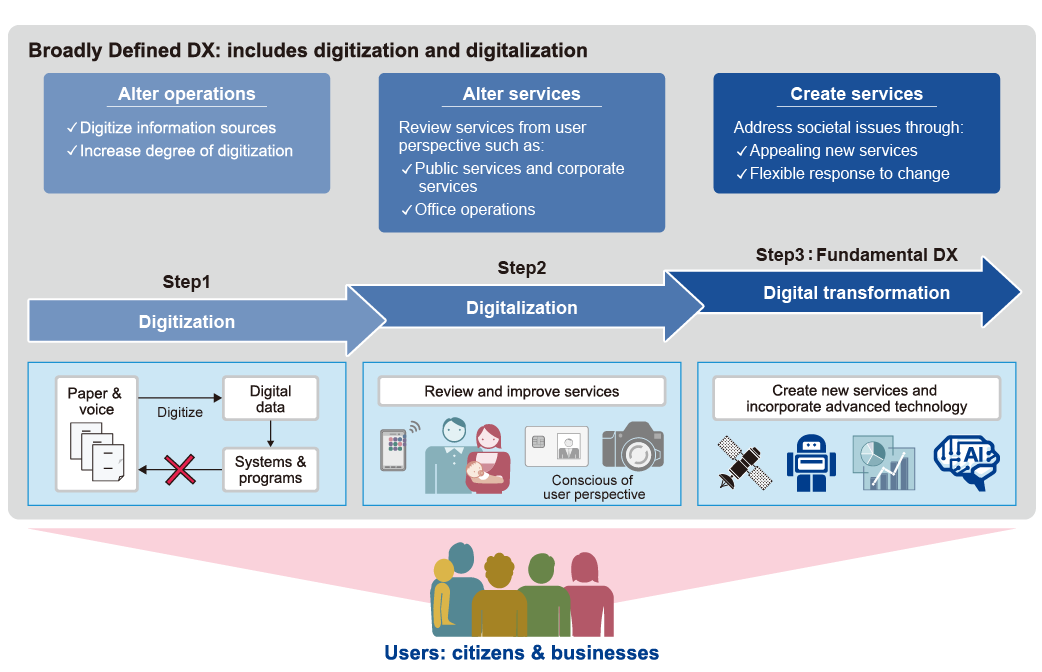With the aim of becoming the world’s most advanced digital nation, Japan has made an effort to use digital information and communications technology (ICT) to radically reform its societal systems, but the results so far have been unimpressive. Japan’s digital competitiveness has been weak. It comes in at 14th in the UN E-Government Survey issued in July 2020 by the United Nation’s Department of Economic and Social Affairs (UN DESA)1, and only 27th in the World Digital Competitiveness Ranking 2020 issued in September 2020 by the Institute for Management Development (IMD) of Switzerland2.
The countries that regularly top the UN e-government ranking see a high level of acceptance for public services provided through the Internet and mobile devices. For example, Denmark, coming in at number one in 2020, has over 90% of its population using Digital Post, a national service that enables citizens to receive correspondence digitally from public institutions and private companies such as banks and insurance companies. Australia too, number five in 2020, has over 90% of citizens registered for its public digital service My Health Record and the accompanying HealthNow mobile app; these services record and store data such as medical records, test results, and prescriptions enabling access to health information for both individuals and their healthcare providers.3
In contrast to this, Japan has only recently achieved a 30% rate of use for its Individual Number Card as of May 2021. Although many public institutions have switched over to electronic application processes, this move has largely been limited to measures such as digitally re-creating paper forms; users are still far from enjoying the ease-of-use and convenience of digital processes.
The world is undergoing radical change making the future ever-more difficult to forecast. Given these circumstances, it is particularly urgent for public administration, which deals with an overwhelmingly higher number of service recipients than the private sector, and financial administration, which is subject to complex regulations and compelled to operate in a global environment, to deliver services in ways that enable rapid adaptation to future changes in social environments and systems, and that provide a high degree of satisfaction to users.
Creating new services by making good use of systems that are already established and linking them together might seem an easy approach, but this approach often goes much less smoothly than expected. Digital transformation (DX) is the key to overcoming the fundamental issues that impede radical reform. DX should be fostered through three main steps, always guided by the goal of creating services based on the needs of users.
The private sector must address DX in its own set of measures.
The countries that regularly top the UN e-government ranking see a high level of acceptance for public services provided through the Internet and mobile devices. For example, Denmark, coming in at number one in 2020, has over 90% of its population using Digital Post, a national service that enables citizens to receive correspondence digitally from public institutions and private companies such as banks and insurance companies. Australia too, number five in 2020, has over 90% of citizens registered for its public digital service My Health Record and the accompanying HealthNow mobile app; these services record and store data such as medical records, test results, and prescriptions enabling access to health information for both individuals and their healthcare providers.3
In contrast to this, Japan has only recently achieved a 30% rate of use for its Individual Number Card as of May 2021. Although many public institutions have switched over to electronic application processes, this move has largely been limited to measures such as digitally re-creating paper forms; users are still far from enjoying the ease-of-use and convenience of digital processes.
The world is undergoing radical change making the future ever-more difficult to forecast. Given these circumstances, it is particularly urgent for public administration, which deals with an overwhelmingly higher number of service recipients than the private sector, and financial administration, which is subject to complex regulations and compelled to operate in a global environment, to deliver services in ways that enable rapid adaptation to future changes in social environments and systems, and that provide a high degree of satisfaction to users.
Creating new services by making good use of systems that are already established and linking them together might seem an easy approach, but this approach often goes much less smoothly than expected. Digital transformation (DX) is the key to overcoming the fundamental issues that impede radical reform. DX should be fostered through three main steps, always guided by the goal of creating services based on the needs of users.
The private sector must address DX in its own set of measures.

